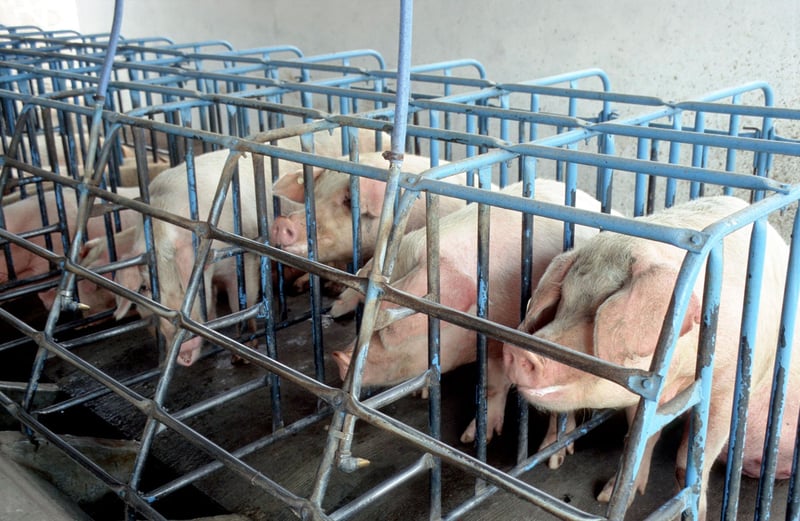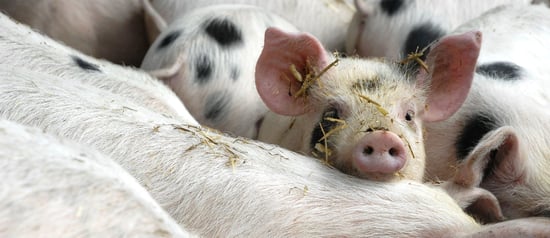
Industrial farming practices often lead to unhealthy diets and food insecurity
Blog
Factory farming systems increase the availability of animal based foods coupled with a reduction in their cost per unit.
Whilst at first sight this may appear to be a good thing for consumers, several decades of experience has shown that industrialised farming practices often lead people to unbalanced and unhealthy diets. These dietary imbalances can then lead to malnutrition, undernutrition and micronutrient deficiencies.
An increase in the availability of inexpensive high-calorie animal based foods has often replaced people’s naturally diverse traditional diets, consisting of local foods and varied cuisines.
Industrial livestock systems has also lead food insecurity in parts of Africa, Asia, and Latin America.
Factory farming can lead to malnutrition
Malnutrition means a lack of proper dietary nutrition, which can be either inadequate and/or unbalanced nutrition.
Malnutrition and hunger pose the highest risks to human health in terms of death and illness1 and these health risks include:
- obesity
- micronutrient deficiencies
- stunting
- wasting
- communicable and noncommunicable diseases
- mental illness
Sub-optimal diets are estimated to be responsible for 20% of premature mortality worldwide2 as well as for 20% of all the number of years lost to ill-health, disability, or early death.3
Obesity health issues
Taking obesity as an example, globally it has nearly tripled since 1975. And there are now 677.6 million obese adults, with 1 in 3 people now overweight.4
It is one of the leading causes of serious health problems such as diabetes, heart disease, stroke, and cancer. These four illnesses are responsible for 41 million of the world’s 57 million total deaths (71%). Diets containing excessive livestock derived foods with too few fruits and vegetables, are one of the four leading risk factors for these diseases.5
Diet related health risks also monopolize large portions of many national health-care budgets. For example, the UK National Health Service spent £6.1 billion on overweight and obesity-related ill-health in 2015, where the overall cost of obesity to wider society is estimated at £27 billion.
Protecting against malnutrition
Humane, healthy, and sustainable diets contain a diversity of nutrient-rich foods, such as:
- vegetables
- fruits
- whole grains
- legumes
- nuts
- unsaturated oils
With lower amounts of:
- white meat
- fish
- dairy
- red meat
- processed meat
- added sugar
- refined grains
- starchy vegetables
Health risks of excessive meat consumption
The industrialisation of farming methods has resulted in cheaper and more consistent meat supplies.
The long-term consumption of increasing amounts of red meat and particularly of processed meat is associated with an increased risk of mortality, cardiovascular disease, colorectal cancer, and type 2 diabetes.6
The future impact of industrial farming practices
A focus on efficiency and the industrialisation of farming has seen an increase in the availability of inexpensive high-calorie livestock derived foods, at the expense of dietary diversity and often the displacement indigenous and healthier foods.
Millions of people in low to middle income countries are currently dependent on traditional farming methods that use extensive mixed or pastoral systems which provide them with their main source of protein and micronutrients.7
The rapid rise in factory farming methods, which is forecast to take place within many of these countries over the next decade, threatens to replace their traditional farming systems, which in turn could result in malnourishment.
What is food insecurity?
The Food and Agriculture Organization of the United Nations defines food security as ‘‘a situation that exists when all people, at all times, have physical, social, and economic access to sufficient, safe and nutritious food that meets their dietary needs and food preferences for an active and healthy life’’. 8
Access to humane and sustainably reared livestock plays a key role in ensuring food security by providing food, employment, and income. This is especially true in low to middle income countries.
The path of livestock industrialisation and diet westernisation also impacts land use globally. To satisfy the growing demand for animal feed, arable land is given up to these crops and more land is made available through deforestation.
This change in land use makes food security more challenging in areas which are already food insecure, such as parts of Africa, Asia, and Latin America.
To address this we need to end the growth of factory farming and support a transition to sustainable healthy proteins that are good people, animals and the planet. To do this we all need to Say Yes to Less.
Say Yes To Less Factory Farming
Read Our Full Hidden Health Risks Report
References
1. WHO. 2021. https://www.who.int/publications/i/item/9789240031814 (accessed 15th September 2021)
2. Afshin A, Sur PJ, Fay KA, Cornaby L, Ferrara G, Salama JS, et al. 2019. Health effects of dietary risks in 195 countries, 1990–2017: a systematic analysis for the Global Burden of Disease Study 2017. Lancet. .393(10184):1958–72. Available from: http://dx.doi.org/10.1016/ (accessed 7th October 2021)
3. Swinburn BA, Kraak VI, Allender S, Atkins VJ, Baker PI, Bogard JR, et al. 2019.The Global Syndemic of Obesity, Undernutrition, and Climate Change: The Lancet Commission report. Lancet. .393(10173):791–846. http://dx.doi.org/10.1016/ (accessed 28th September 2021)
4. GNR. 2020. Global Nutrition Report: Action on equity to end malnutrition. Bristol, UK: Development Initiatives. (accessed 7th October 2021)
5. WHO 2018.Noncommunicable diseases https://www.who.int/news-room/fact-sheets/detail/noncommunicable-diseas… (accessed 16th September 2021)
6. Battaglia Richi E et al. 2015. Health Risks Associated with Meat Consumption: A Review of Epidemiological Studies. Int J Vitam Nutr Res. 2015;85(1-2):70-8. doi: 10.1024/0300-9831/a000224. PMID: 26780279. (accessed 17th September 2021)
7. CGIAR. 2019. Global Burden of Diseases. https://www.oie.int/onehealthconference2019/wpcontent/uploads/2019/10/2… (accessed 17th September 2021)
8. FAO. 2006. Food security policy brief. Issue #2
http://www.fao.org/fileadmin/templates/faoitaly/documents/pdf/pdf_Food_… (accessed 20th September 2021)
Image credits: Blog listing Walter Otto/Unsplash; Blog post: World Animal Protection

Become part of the community
Join thousands of animal lovers fighting to protect wildlife and give farmed animals good lives. Sign up now for emails with ways you can help.
Sign up now